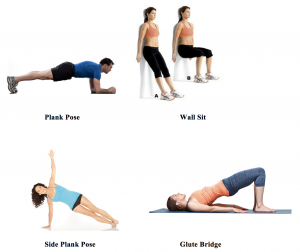Isometric Exercise and Alzheimer’s Disease

Catherine O’Brien
Alzheimer’s Disease is the leading cause of dementia and currently affects an estimated 5.5 million American adults (Center for Disease Control, 2016). Unfortunately, the Center for Disease Control predicts that the incidence of Alzheimer’s will increase in the coming years. The early stages of the disease are marked by Mild Cognitive Impairment (MCI) which can include problems with memory, thinking, language and problem-solving. MCI is identified as greater cognitive impairment compared to that which is associated with normal aging.
As the disease progresses, plaques and tangles continue to form, dementia worsens and, ability to carry out normal activities of daily living declines. There are numerous risk factors including age, family history, and genetics. The Alzheimer’s organization also points to other conditions that have been shown to be related to the development of AD including head trauma, diabetes, vascular problems, heart disease and high blood pressure (hypertension).
 According to the Center for Disease Control, about 32% of American adults have high blood and approximately 1 in 3 American adults are considered pre hypertensive (meaning that they are heading toward hypertension). High blood pressure is a major health concern as it is related to the development of many other diseases, including Alzheimer’s.
According to the Center for Disease Control, about 32% of American adults have high blood and approximately 1 in 3 American adults are considered pre hypertensive (meaning that they are heading toward hypertension). High blood pressure is a major health concern as it is related to the development of many other diseases, including Alzheimer’s.
An article by Hess and Smart in the Frontiers of Aging Neuroscience discusses the relationship between hypertension, vascular risk factors, and Alzheimer’s Disease. “The vascular hypothesis of AD proposes that cerebral hypo perfusion is the causal factor in disease development” (Hess & Smart, 2017, p 4). So how do vascular issues lead to problems in the brain? Hypo perfusion is a reduction of cerebral blood flow and insufficient blood flow reduces transportation of oxygen and nutrients leading to damaged neural activity.
Clearly, given the numerous risk factors and the incidence of the disease, research is acutely focused on discovering a treatment for AD. While presently there is no known cure for AD, there are therapies that have been associated with the reduction of symptoms; Exercise is among these therapies.
Recently,
an article in the Frontiers in Aging Neuroscience examined the effects of isometric exercise on Mild Cognitive Impairment associated with AD. Isometric exercise has become increasingly popular over the past few years and based on the research discussed by Hess and Smart, may be as good for your brain as it is for your body.
Isometric exercise is a type of strength training in which the length of the muscle and joints involved do not noticeably move. These exercises involve holding a specific position while contracting the muscles involved. Examples of isometric exercises include planks, side planks, wall sits, and bridges (see below for examples).
In their article, Hess and Smart discussed the positive effects of isometric exercise on reducing blood pressure and the success of previous studies which employed isometric exercise training rather than the usually preferred method of aerobic training. In this way, research has shown that isometric exercise effectively reduces blood pressure (a key risk factor associated with cognitive decline).
 Enhance the intensity of your workout with HyperWear Gear and save space with their SandBell Weights.
Enhance the intensity of your workout with HyperWear Gear and save space with their SandBell Weights.
Takeaways:
This research is interesting and important because it points to yet another form of exercise that is effective in treating vascular problems. Additionally, the lower intensity of this type of exercise (compared to HIIT and aerobic exercise) may make it more accessible to aging populations. Given aging is a primary risk factor associated with AD, it is important that therapies are suitable for individuals as they age so they can continue to engage in and benefit from the exercise program.
Whether you are dealing with hypertension or are just looking for a way to switch up your workout routine, isometric exercise training is a great fit for your fitness and health needs. Of course, individuals with hypertension or other health concerns should consult a physician prior to beginning any exercise regimen.
You Might Like:
Reduce Cigarette Cravings with Acute Exercise
Catherine O’Brien It is no secret that smoking is a major health hazard that significantly increases risk of cancer, heart disease, stroke and other health problems. That said, 20% of adult men and 16% of...Effects of Outdoor Exercise
Catherine O’Brien Why Does Exercising Outdoors Feel So Much Better? I have always been a proponent of outdoor exercise, particularly running. There is something so satisfying and therapeutic about the fresh air and the sound...Music – Your HIIT Recovery Secret Weapon
Catherine O’Brien The effects of music on exercise experience is a common theme throughout my articles. I am always interested in the relationship between music and physical activity and how music can alter an exercise...Vestibular Migraines: Could Exercise Be The Answer?
Catherine O’Brien My last article highlighted the inverse relationship between headaches and VO2 max levels such that individuals who experienced headaches regularly had, on average, lower VO2 peaks than their control counterparts. Perhaps one of...Which Is Better For The Brain – Long Duration Or Short High Intensity Exercise?
Catherine O’Brien High intensity interval training (HIIT) is a form of exercise that utilizes “repeated bouts of short-to-moderate duration exercise at an intensity of 85-90% of peak oxygen uptake or 90-95% of peak heart rate...3 Strength Exercises For Individuals With Essential Tremor
Catherine O’Brien Essential tremor (ET) is a neurological disorder characterized by involuntary and rhythmic shaking. Typically, tremors occur in upper extremities such as the hands but tremors can exist in other body parts as well...References:
The Center for Disease Control and Prevention (2016) High Blood Pressure Fact Sheet. Retrieved on September 12, 2017 from https://www.cdc.gov/dhdsp/data_statistics/fact_sheets/fs_bloodpressure.htm on
The Center for Disease Control and Prevention (2017) Deaths from Alzheimer’s Disease – United States, 1999-2014. Retrieved on September 12, 2017 from https://www.cdc.gov/mmwr/volumes/66/wr/mm6620a1.htm
Hess, N.C.L, and Smart, N.A. (2017). Isometric exercise training for managing vascular risk factors in mild cognitive impairment and Alzheimer’s Disease. frontiers in Aging Neuroscience, 9(48), 1-12.
Laskowski, E.R. (2014) The Mayo Clinic: Are isometric exercises a good way to build strength. Retrieved on September 12, 2017 from http://www.mayoclinic.org/healthy-lifestyle/fitness/expert-answers/isometric-exercises/faq-20058186
















